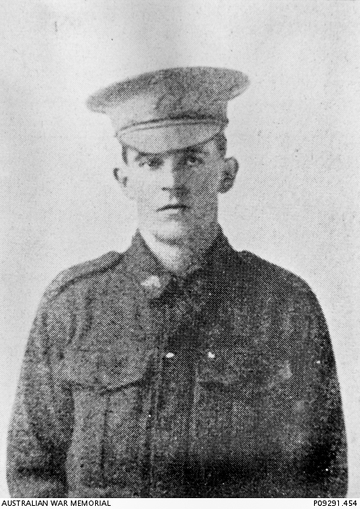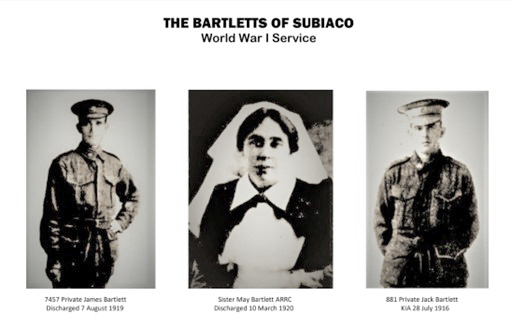Jack BARTLETT
Eyes brown, Hair dark, Complexion dark
The Bartletts of Subiaco
Can you help us identify Jack?
Jack Bartlett was Killed in Action at Fromelles. As part of the 32nd Battalion he was positioned near where the Germans collected soldiers who were later buried at Pheasant Wood. There is a chance he might be identified, but we need help. We are still searching for suitable family DNA donors.
In 2008 a mass grave was found at Fromelles, a grave the Germans dug for 250 (Australian) bodies they recovered after the battle.
If you know anything of contacts or his relatives from Western Australia, please contact the Fromelles Association.
See the DNA box at the end of the story for what we do know about his family.
With thanks to Geoff Tilley, In Search of Charles Albert Stokes DCM, for his contribution to the preparation of this story.
Jack Bartlett was born in 1892 in Armidale in the northern tablelands of New South Wales to Richard Clifford and Jane Gale (nee Smith) Bartlett. He was the youngest of their ten children:
- Richard Adelaide Bartlett 1874–1945
- Daisy Bartlett 1876–1937
- Jane Bartlett 1878–1963
- Amelia "Millie" Bartlett 1880–1937
- Henry "Harry" Bartlett 1881–1957
- John Bartlett 1884–1884
- May Bartlett 1885–1971
- William Bartlett 1887–1957
- James Bartlett 1889–1967
- Jack Bartlett 1892–1916
The family also briefly lived in Brisbane, Queensland before moving to Subiaco, Perth, Western Australia in the later part of the 1890s. Jack’s mother died December 1900 when Jack was just 8, but he certainly had a substantial family to see to his upbringing. Jack’s father worked as a plastering contractor in Subiaco and Jack and his brother James were apprenticed to their father as plasterers. A number of his brothers were also in the building/carpentry trades. Jack married Elsie Jane Howard after he enlisted in 1915. They had a son, whom Jack never got to meet, Jack Clifford Bartlett, born in December 1915. Elsie was living in Busselton when their son was born.
Off to War
The Bartlett family gave good support to the War effort. Jack’s sister May Bartlett joined the Australian Army Nursing Service in June 1915. In 1919 she was awarded the Royal Red Cross, 2nd Class for her work in India and continued to work at a Perth hospital for many years. Jack’s older brother James enlisted in October 1916. He served with the 16th and 44th Infantry Battalions. He survived the War and returned to Australia in 1919. He also served in WW2.
Jack enlisted on 7 July 1915 at Blackboy Hill, outside of Perth and was attached to newly formed 32nd Battalion, C Company. The 32nd had been raised on the outskirts of Adelaide, South Australia as part of the 8th Brigade, with A and B Companies to be from South Australia and C and D Companies from Western Australia. At the end of September 1915, Jack sailed from Fremantle to Adelaide with other WA enlistees of the 32nd Battalion to join the other half of the battalion and to continue their military training. He embarked from Adelaide, South Australia in November 1915 aboard HMAT Geelong A2, headed for Egypt.
They arrived in Suez on 14 December 1915 and moved to El Ferdan just before Christmas. A month later they marched to Ismailia, then to the large camp at Tel El Kabir for February and most of March. The next stop was at Duntroon Plateau and Ferry Post until the end of May, training and guarding the Suez Canal. Their last posting in Egypt was a few weeks at Moascar.
One soldier’s diary complained of being “sick up to the neck of heat and flies”, of the scarcity of water during their long marches through the sand and he described some of the food as “dog biscuits and bully beef”. He did go on to mention good times as well, with swims, mail from home, visiting the local sights and the like. Source AWM C2081789 Diary of Theodor Milton PFLAUM 1915-16 You can read Theodor’s Soldier Story here
During their time in Egypt the 32nd had the honour of being inspected by H.R.H. Prince of Wales. After spending six months in Egypt, the call to support the British Expeditionary Force on the Western Front came in mid-June. They left from Alexandria on the ship Transylvania on 17 June 1916 and arrived at Marseilles, France on 23 June 1916. They then departed by train for the two-day trip to Steenbecque, near the Belgian border. Their route took them to a station just out of Paris, within sight of the Eiffel Tower, then through Bologne and Calais, with a view of the Channel before marching to their camp at Morbecque, about 30 kilometres from Fleurbaix.
Theodor Pflaum (No. 327) wrote about the trip in his diary:
“The people flocked out all along the line and cheered us as though we had the Kaiser as prisoner on board!!”
Fromelles
The 32nd moved to the Front on 14 July and were into the trenches for the first time on 16 July, in preparation for an assault on the German trenches at Fromelles. D Company’s Lieutenant Sam Mills’ letters home were optimistic for the coming battle:
“We are not doing much work now, just enough to keep us fit—mostly route marching and helmet drill. We have our gas helmets and steel helmets, so we are prepared for anything. They are both very good, so a man is pretty safe.”
On the 17th they were reconnoitering the trenches and cutting passages through the wires, preparing for an attack, but it was delayed due to the weather.
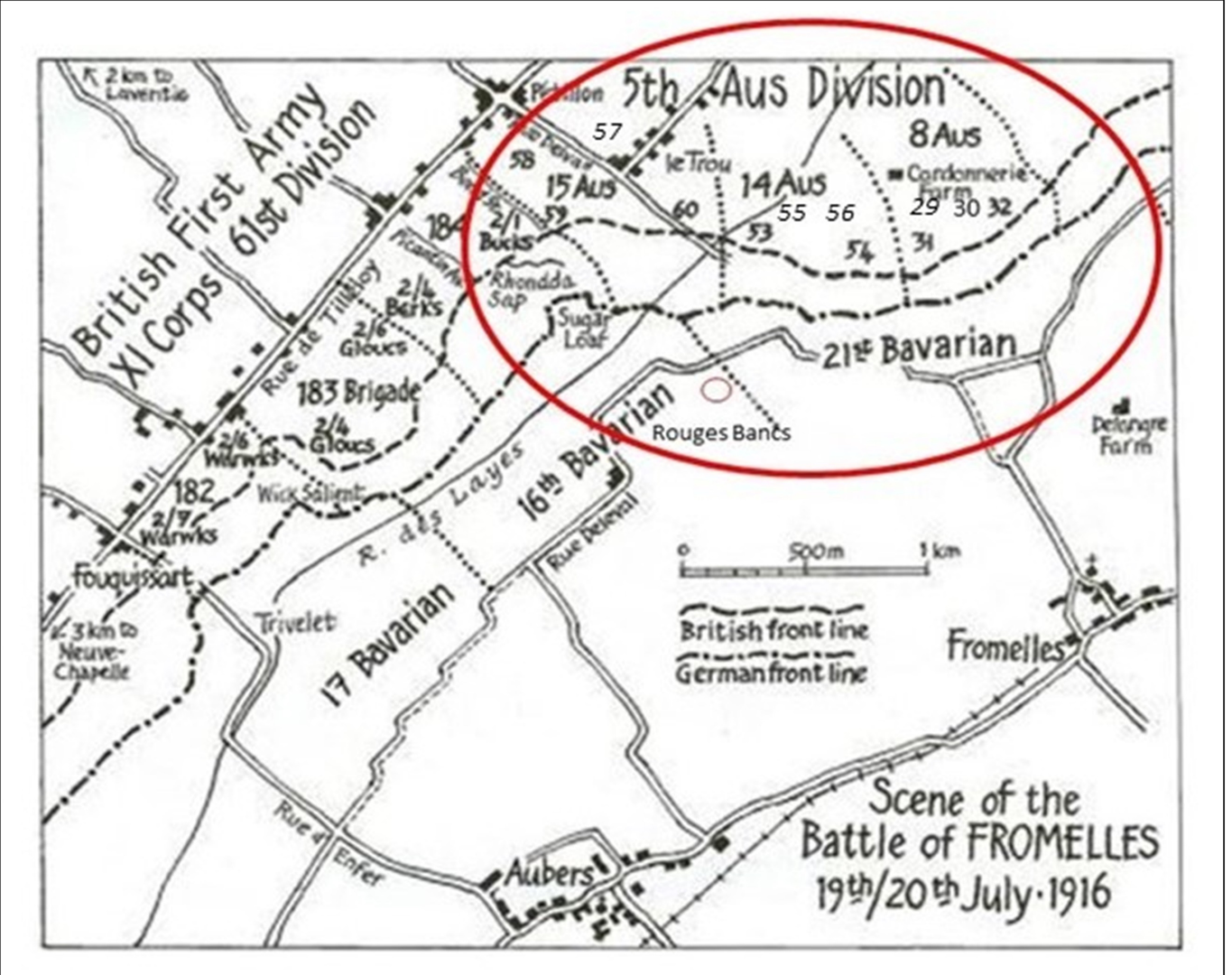
The Australian 8th Brigade, which included the 32nd Battalion, were to cross about 100 metres of No-Man’s-Land and assault the German trenches on the left flank of the Allied attack. Being on the extreme left flank made their job made even more difficult, as, not only did they have to protect themselves from the front, but they also had to block off the Germans on their left while advancing in order to prevent the Germans from coming around behind them.
All were in position by 5.45 PM and the charge over the parapet began at 5.53 PM. Jack’s C Company and A Company were the first and second waves to go, B & D the third and fourth. The first waves did not immediately charge the German lines, they went out into No-Man’s-Land and laid down, waiting for the British bombardment to lift.
At 6.00 PM, the German lines were rushed. The Australians immediately suffered heavy casualties from the artillery and German rifle and machine gun fire, including Jack. Jack’s fate was witnessed by Private Thomas Skehan (1051), who states in Australian Red Cross Wounded and Missing files dated from January 1917, that he saw Bartlett killed:
“We were charging at the time of his death he had just gone over the parapet, and he was hit almost instantaneously falling back against the parapet dead. About two hours later I noticed him laying on the ground face downwards dead.”
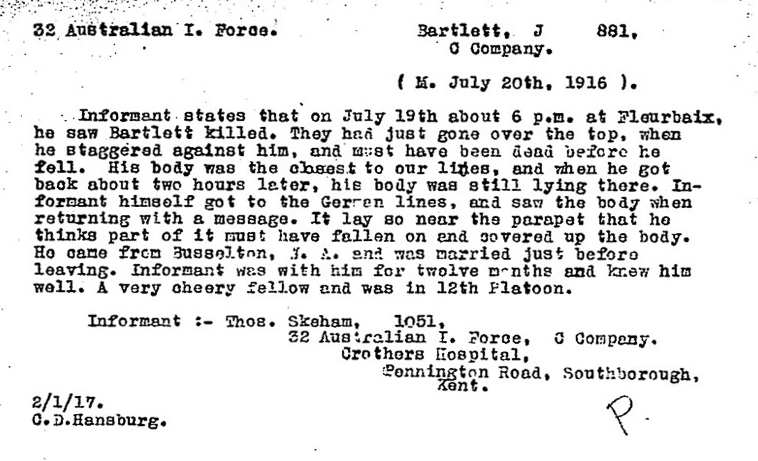
Sadly, even though Jack was killed so close to the Australian lines, the urgency of the battle left the soldiers no alternative but to leave him and keep moving on. The 32nd were successful in their initial assaults and by 6.30 PM were in control of the German’s 1st line system. Fighting continued through the night. The Australians made a charge at the main German line, but they were low on grenades, there was machine gun fire from behind and from the machine gun emplacement at Delangre Farm and they were so far advanced that they were getting shelled by both sides.
At 4.00 AM the Germans began an attack from the Australian’s left flank. Given the Australian advances that had been made earlier, their rear trench had been left almost empty, which then enabled the Germans to be in a position to surround the soldiers of the 32nd.
At 5.30 AM the Germans attacked from both flanks in force and with bombing parties:
“The enemy swarmed in and the retirement across No Mans’ Land resembled shambles, the enemy artillery and machine guns doing deadly damage.”
What was left of the 32nd had finally withdrawn by 7.30 AM on the 20th. The initial head count was devastating – 71 killed, 375 wounded and 219 missing. The final impact was that 226 soldiers of the 32nd Battalion were killed or died from wounds sustained at the battle and of this 166 were unidentified. As of 2024, 41 of these soldiers from the 32nd have been identified from the German mass grave at Pheasant Wood found in 2008.
Jack was officially reported as missing in action
While Thomas Skehan’s witness statement said that Jack was killed near the Australian lines, his body might have been able to be recovered after the battle. However, he remained one of those who were “Missing in Action”. To get some perspective of the battle, when Charles Bean, Australia’s official war historian, attended the battlefield two and half years later, he observed a large amount of bones, torn uniforms and Australian kit still on the battlefield.
With no further news after being initially notified that Jack was missing, Jack’s father wrote to the Red Cross in July 1917 making enquiries about his son. He had been told by a returned soldier (Burgess), that he had met Jack in Weymouth Camp, England in February 1917 and said Jack was under observation for six months having been wounded in the hand. Burgess’ physical description aligned with Jack’s father’s expectations.
There was also a separate Red Cross report about Jack having only been slightly wounded.
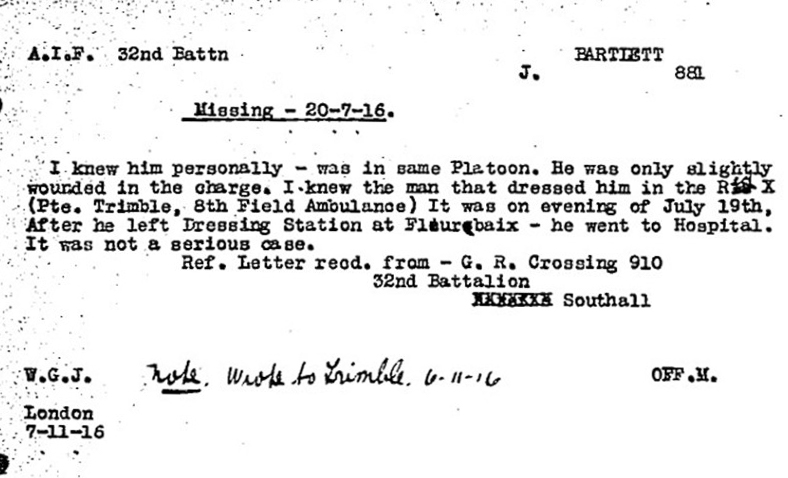
Enquiries were made by the Army at the Weymouth Camp, but there was no record of Jack having been at that camp. This may have been a case of mistaken identity as a Private John “Jack” Bartlett, 3015, also from WA, who was part of the 32nd and 29th Battalions in 1916 and was in Weymouth in 1917.
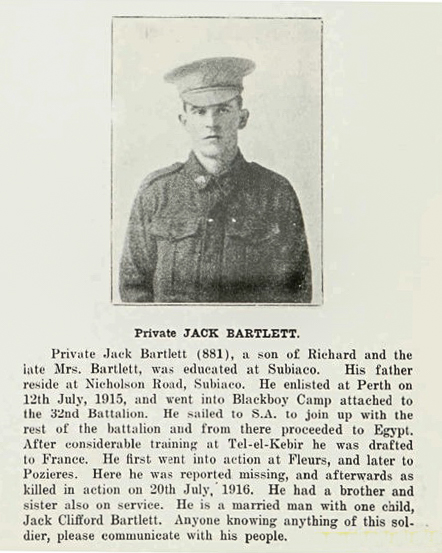
It was by a Court of Inquiry in the Field on 8 August 1917, that Jack was pronounced Killed in Action on 20 July 1916. He has no known grave.
Jack is commemorated at:
- VC Corner Panel 4 Australian Military Cemetery, Fromelles France.
- Kings Park Honour Avenue
- Subiaco Fallen Soldiers Memorial
- Australian War Memorial Panel 119, Canberra
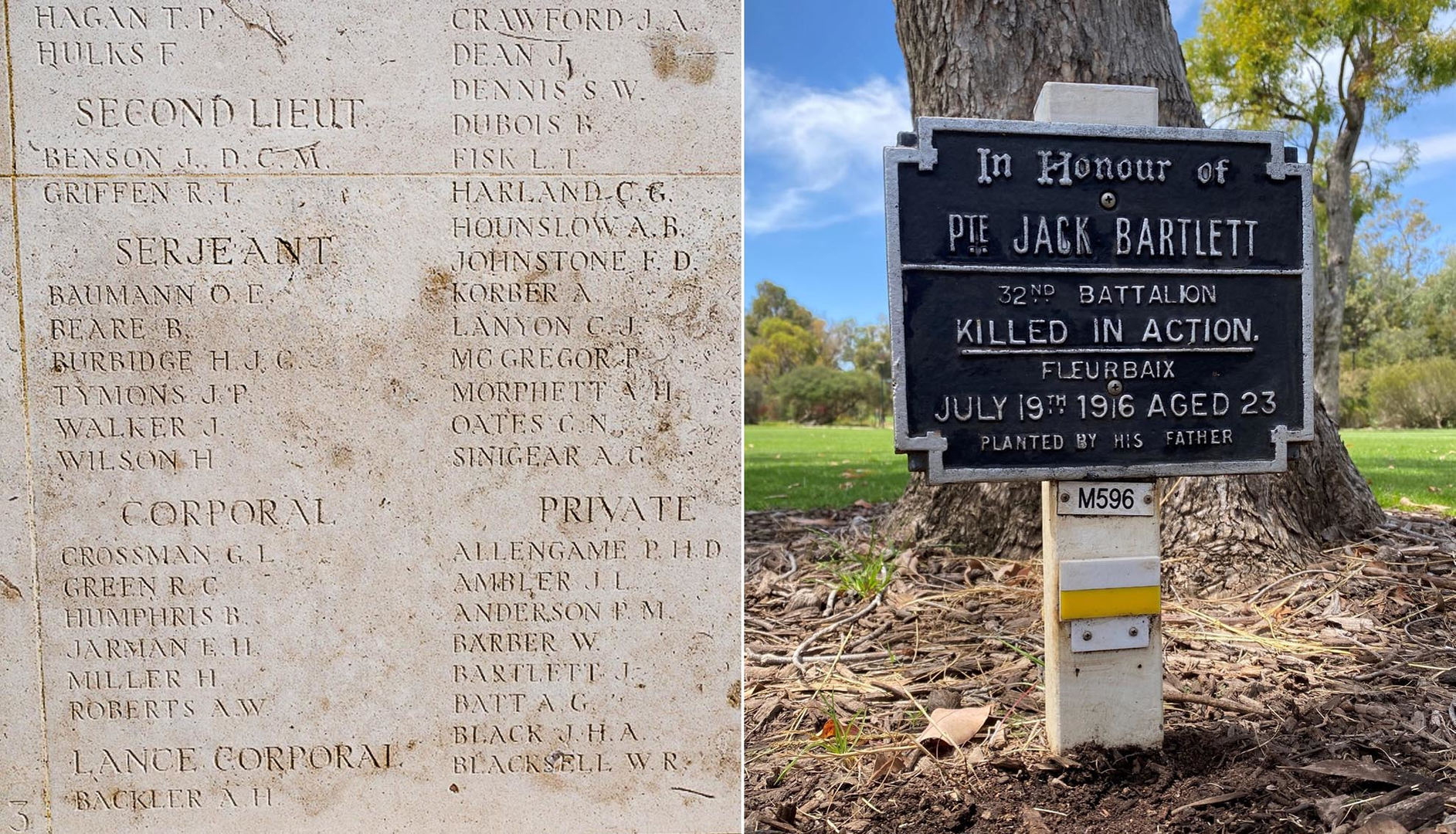
After the War – the Bartletts Continue to Serve
After news of Jack's death filtered through, Elsie Jane, with her 1 year old Jack Jnr, moved closer to family and lived in Busselton, WA before moving to Perth WA in 1929, where she worked as a waitress. By 1949 Elsie was living in Rockingham WA. She passed away in 1966.
Their son who Jack never met, Jack Clifford Bartlett, followed in his father’s footsteps and enlisted in WW2 in 1941. Jack’s brother James had survived WW1 and enlisted again, at 50 years old, to serve in WW2.
Jack went on to serve in Bougainville (14 May 1945 - 21 February 1946). He was a Corporal attached to the Australian Electrical and Mechanical Engineers. He was discharged in August 1946. Jack's wife, Mavis Isobel (nee Arbuthnott), also enlisted and served in the Australian Army Medical Women's Service from 1942 to 1947 in New Guinea and Bougainville. James worked at the Marrinup POW camp in WA.
We may still be able to identify Jack, but need your help
As of 2024, 41 of the 166 unidentified soldiers from the 32nd have been found to be from the German mass grave at Pheasant Wood that was discovered in 2008. Identification has been able to be done by DNA matching from family members.
Jack may be one of the 70 remaining soldiers in the grave who are not yet identified. We need to find family members to contribute DNA samples to find out.
DNA samples are being sought for family connections to
| Soldier | Jack Bartlett (1892-1916} married Elsie Jane Howard, 1 son, Jack Clifford Bartlett 1915-1974 |
| Parents | Richard Clifford Bartlett (1846-1923) and Jane Gale Smith (1846-1900) |
| Siblings | Richard Adelaide Bartlett (1874–1945) | ||
| Daisy Bartlett (1876–1937) | |||
| Jane Bartlett (1878–1963) | |||
| Amelia "Millie" Bartlett (1880–1937) | |||
| Henry "Harry" Bartlett (1881–1957) | |||
| John Bartlett (1884–1884) | |||
| May Bartlett (1885–1971) | |||
| William Bartlett (1887–1957) | |||
| James Bartlett (1889–1967) |
| Grandparents | |||
| Paternal | Richard Bartlett and Unknown | ||
| Maternal | John Smith and Isabella Unknown |
Note. Son Jack Clifford Bartlett (1915-1974) married Mavis Isobel Arbuthnott (1918-1986)
The Fromelles Association would love to hear from you

Contacts
(Contact: carla@fromelles.info or geoffrey@fromelles.info).
(Contact: army.uwc@defence.gov.au or phone 1800 019 090).
Donations
If you are able, please contribute to the upkeep of this resource.
(Contact: bill@fromelles.info ).
